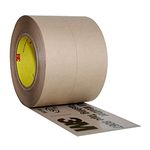What's the Difference: Copper tubing
When it comes to copper tubing for residential plumbing and heating, there is a litany of options
Type K, type L or type M?
Despite the inevitable rise of plastics, copper tubing is still the traditional choice for residential plumbing. Sold in straight sections or in rolls (photo below), copper tubing is available in a variety of diameters and in seven different weights. Only three of them—type K, type L and type M—are typically used for water-supply lines. A fourth type—drain, waste and vent (DWV)—can still be found in many an older house. But because of cost, its use is probably on the decline.
All are made of 99.9% pure copper to conform with standards of the American Society of Testing and Materials. Outside diameters are 1⁄8 in. more than nominal sizes. That is, 1⁄2-in. tubing has an outside diameter of 5⁄8 in. What’s different about type M 1⁄2-in. tubing and type L 1⁄2-in. tubing? Wall thickness, which in turn affects the inside diameter, the water-carrying capacity and the rated internal working pressure. For example, 1⁄2-in. type M, the lightest grade, has an inside diameter of 0.567 in. and a wall thickness of 0.028 in. Type L, the next heaviest, has an inside diameter of 0.545 in. and a wall thickness of 0.40 in. Type K, the heaviest of the three, has an inside diameter of 0.527 in. and a wall thickness of 0.049 in.
Although these increments may seem like small differences, they change the physical characteristics of the tubing considerably. The internal working pressure of type-K 1⁄2-in. tubing, for instance, is 80% greater than that of type M. This difference doesn’t amount to a hill of beans, though, for residential plumbing because working pressures are so low.
Copper tubing is available in both hard and soft tempers. Hard copper, what the industry may call drawn tubing, is sold in straight lengths of up to 20 ft. Soft, or annealed, copper is sold in rolls up to 100 ft. in length (type M is not available by the roll). A bending temper tubing also is available in straight lengths. One advantage of using rolled copper is that a long run won’t require as many soldered connections. Also, according to The Copper Tube Handbook, published by the Copper Development Association, soft copper tubing is more resistant to freeze-thaw damage (for a full helping of detailed information on copper tubing, check the association’s Web site, www.copper.org).
Both the International Plumbing Code (published by the International Code Council) and the older Uniform Plumbing Code (UPC) allow type-M tubing for water service and water distribution within a building. The UPC, however, does not permit type M to be used underground within a building (such as in a slab). There, according to the code, type L must be used. For heating systems, covered by separate mechanical codes, type M is permitted in many situations, but as always, it’s a good idea to check local codes. (An excellent summary of the IPC and the UPC can be found in Redwood Kardon and Jeff Hutcher’s Code Check Plumbing; The Taunton Press, 1999).
Heavier weight of tubing costs more but may provide longer life
Local practice, and the nagging feeling that heavier is better, often prompt plumbers and builders to use type L or even type K where type M is permitted. Sometimes this use is proved by experience. Although copper is resistant to corrosion, there are conditions that copper tubing doesn’t like. They include hard well water; soft, acidic water; excessive water velocity or turbulence in the line; too much flux during installation; and what the Copper Development Association calls “aggressive soil conditions.” Those who have had trouble with thinner-walled tubing may switch to type L or type K for longer service life.
Recognizing what you’re buying should be easy. The name of the manufacturer, the country of origin and the type of tubing are incised into the pipe to make identification easy. In addition, types K, L and M hard tubing are color-coded. Printing is green on type-K tubing; blue on type L; and red on type M. As you might expect, the heavier the tube, the higher the cost. Prices quoted by a Massachusetts distributor show type-K 1⁄2-in. tubing costs about 25% more than type L, which in turn was about 25% more than type M. In 1⁄2-in. soft tubing, the price difference between type L and type K was only about 15%.
Despite rules on incising and color-coding, labeling can be confusing, even misleading. I bought a 25-ft. roll of tubing that was labeled “1⁄2-in. L general-purpose grade tubing” from a Home Depot in Connecticut last summer only to find that its wall thickness was just over half of what type L is supposed to be by industry standards (0.022 in. vs. 0.040 in.). So I called the manufacturer, Anderson Barrows, to ask what was going on. A customer-service representative said that particular wall thickness corresponds to what Anderson Barrows calls “CTF” tubing, a general-purpose or utility grade. Because the industry is specific about which type of tubing is to be used for which purpose, just what CTF is intended for is anyone’s guess. Anderson Barrows says it has since revised its labeling.
Copper tubing is available in straight lengths and by the roll
Most copper tubing used in residential plumbing will be straight runs of type M or type L, such as these samples. Type-L rolled tubing is softer.
Fine Homebuilding Recommended Products
Fine Homebuilding receives a commission for items purchased through links on this site, including Amazon Associates and other affiliate advertising programs.

8067 All-Weather Flashing Tape

Affordable IR Camera

Handy Heat Gun


















